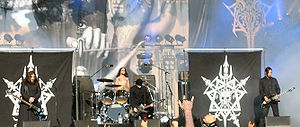
Back سلتیک فراست AZB Celtic Frost Byelorussian Селтик Фрост Bulgarian কেল্টিক ফ্রস্ট Bengali/Bangla Celtic Frost Catalan Celtic Frost Czech Celtic Frost Danish Celtic Frost German Celtic Frost Greek Celtic Frost Spanish
Celtic Frost | |
|---|---|
 Celtic Frost live at Tuska Open Air Metal Festival 2006. The band's distinctive skull-and-spears logo can be seen on the banners. | |
| Background information | |
| Origin | Zürich, Switzerland |
| Genres | |
| Years active | 1984–1987, 1988–1993, 2001–2008 |
| Labels | Century Media, Noise, Metal Blade |
| Spinoffs | Triptykon |
| Spinoff of | Hellhammer |
| Past members |
|
| Website | celticfrost.com |
Celtic Frost (/ˈkɛltɪk frɒst/)[1] was a Swiss heavy metal band from Zürich. They are remembered for their strong influence on the development of several metal subgenres, particularly extreme metal,[2][3] and for their avant-garde approach to music in general.[4]
In June 1984, guitarist and vocalist Thomas Gabriel Fischer and bassist Martin Eric Ain formed Celtic Frost after disbanding their previous band, Hellhammer, a month earlier. Celtic Frost's debut record, Morbid Tales, was released in November of that year.[5] This was followed by the full-length studio albums To Mega Therion (1985) and Into the Pandemonium (1987).[2] All three records are considered highly influential landmarks in heavy metal. While each contains elements of avant-garde composition, Into the Pandemonium is particularly noted for its unique style and experimentation with musical boundaries beyond the heavy metal genre.
Celtic Frost's next album, Cold Lake (1988), featured a new lineup and a dramatic stylistic shift, which was widely criticized for its commercial and flamboyant tone.[2][4] After releasing Vanity/Nemesis (1990), the band temporarily disbanded. Celtic Frost re-formed in 2001 and released the critically acclaimed Monotheist (2006), eventually disbanding permanently following Fischer's departure in 2008.[6]
Throughout the band's career, their music incorporated elements from various extreme metal styles. Their early work is often classified as thrash metal or black metal with experimental tendencies, while their final album is described as doom metal. Celtic Frost drew inspiration from early heavy metal bands such as Black Sabbath, Judas Priest, and Venom, gothic rock acts like Bauhaus, Siouxsie and the Banshees, Christian Death,[7] and Joy Division,[8] as well as hardcore punk groups like Discharge[9] and GBH.[10]
- ^ "Interview with Tom G. Warrior". Metal Rules. November 1999. Archived from the original on 28 August 2012. Retrieved 21 June 2013.
- ^ a b c Bukszpan, Daniel. The Encyclopedia of Heavy Metal. Barnes & Noble Publishing, 2003. p.43
- ^ "Celtic Frost Profile". Centurymedia.com. Archived from the original on 22 February 2008. Retrieved 26 March 2008.
- ^ a b Wagner, Jeff. Mean Deviation. Bazillion Points Books, 2010. pp.116-124
- ^ Fischer p.80
- ^ September 9, 2008 – PRESS RELEASE Retrieved from Internet Archive 6 January 2014.
- ^ Cite error: The named reference
pyrowas invoked but never defined (see the help page). - ^ Cite error: The named reference
louderwas invoked but never defined (see the help page). - ^ J. Bennett, "Procreation of the Wicked", Precious Metal: Decibel Presents the Stories Behind 25 Extreme Metal Masterpieces, Albert Mudrian, ed., Da Capo Press, p. 34.
- ^ "The Triumph of Tom G. Warrior". Rolling Stone. Archived from the original on 17 February 2022. Retrieved 27 August 2021.